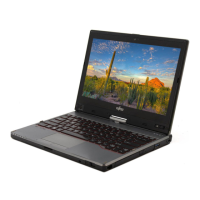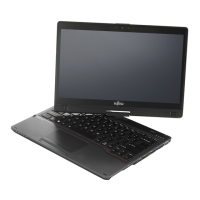What to do if Fujitsu Laptop shows Keyboard controller error?
- NnortizSep 9, 2025
Switch the notebook off with the ON/OFF button. Wait 3 - 5 seconds and switch on the notebook again.

What to do if Fujitsu Laptop shows Keyboard controller error?
Switch the notebook off with the ON/OFF button. Wait 3 - 5 seconds and switch on the notebook again.
What to do if my Fujitsu LIFEBOOK T725 Laptop cannot be started?
There are a few reasons why your Fujitsu Laptop might not be starting. Make sure the battery is correctly installed in its compartment. If the battery is dead, charge it, insert a charged battery, or connect the mains adapter. Also, verify that the power adapter is correctly connected to the notebook. Then, try switching the notebook on.
What to do if external monitor is blank or image is unstable on Fujitsu LIFEBOOK T725 Laptop?
If the external monitor is blank or the image is unstable, it could be due to the wrong external monitor being selected or the wrong screen resolution being set for the application program. Terminate the application program by pressing Alt + F4. If the issue continues, switch to the notebook’s LCD screen using the key combination. Change the screen resolution as described in your operating system’s documentation and select monitor 1 or 2.
What happens if I lost my Fujitsu LIFEBOOK T725 SmartCard?
If you have lost your User SmartCard, you can continue working with the Supervisor SmartCard and initialise a new User SmartCard or deactivate the SystemLock function. If you have lost the Supervisor SmartCard, you can continue working, but you no longer have all your rights and can no longer initialise a Supervisor SmartCard. If you have lost both SmartCards, you can no longer boot your system.
What to do if Smart Card is lost on Fujitsu LIFEBOOK T725?
If you are working in a network, contact your system administrator, who can boot your notebook with a Supervisor Smart Card.
What to do if Fujitsu LIFEBOOK T725 Laptop shows nnnnK Shadow RAM failed at offset?
Contact your sales outlet or our customer service center.
What to do if Fujitsu LIFEBOOK T725 stylus input not working?
If your device is one which can only be operated using the stylus, install the driver for the standard model. If your device is one which can be operated using the stylus and by finger, install the driver for the "Dual Digitizer" model.
What to do if Fujitsu LIFEBOOK T725 date or time is incorrect?
With the BIOS-Setup-Utility, you can set the date and time in the Main menu. Please contact your sales outlet or our hotline/service desk.
How to correct the date or time on my Fujitsu LIFEBOOK T725?
To set the date and time on your Fujitsu Laptop, use the BIOS-Setup-Utility in the main menu. If this does not work, please contact your sales outlet or our Hotline/Service Desk.
Why doesn't the battery indicator illuminate on my Fujitsu Laptop?
If the battery indicator does not illuminate, it could be due to a couple of reasons. First, ensure the battery is correctly installed in its compartment, after switching the notebook off and then on. If the battery is fully discharged, charge it, install a charged battery, or connect the notebook to a mains outlet using the mains adapter.
| Form factor | Convertible (Swivel) |
|---|---|
| Product type | Hybrid (2-in-1) |
| Product color | Black, Silver |
| Bus type | DMI2 |
| Stepping | F0 |
| Tjunction | 105 °C |
| Processor cache | 3 MB |
| Processor cores | 2 |
| Processor model | i5-5200U |
| System bus rate | 5 GT/s |
| Processor family | Intel® Core™ i5 |
| Processor series | Intel® Core™ i5-5200 Mobile Series |
| Processor socket | BGA 1168 |
| Processor threads | 4 |
| Processor codename | Broadwell |
| Processor frequency | 2.2 GHz |
| Processor cache type | Smart Cache |
| Configurable TDP-down | 7.5 W |
| Processor lithography | 14 nm |
| Processor manufacturer | Intel |
| Processor front side bus | - MHz |
| PCI Express slots version | 2.0 |
| Processor boost frequency | 2.7 GHz |
| Processor operating modes | 32-bit, 64-bit |
| ECC supported by processor | No |
| PCI Express configurations | 4x1, 2x4 |
| Thermal Design Power (TDP) | 15 W |
| Configurable TDP-down frequency | 0.6 GHz |
| Maximum number of PCI Express lanes | 12 |
| Motherboard chipset | - |
| Memory slots | 1x SO-DIMM |
| Internal memory | 8 GB |
| Memory clock speed | 1600 MHz |
| Memory form factor | On-board + SO-DIMM |
| Internal memory type | DDR3-SDRAM |
| Maximum internal memory | 12 GB |
| Memory layout (slots x size) | 1 x 4 GB |
| AC adapter included | Yes |
| Intel® Virtualization Technology (Intel® VT) | VT-d, VT-x |
| SSD capacity | The Solid State Drive's storage capacity in Gigabytes. |
| SSD interface | SATA III |
| Storage media | SSD |
| Total storage capacity | 128 GB |
| Compatible memory cards | SD, SDHC, SDXC |
| Number of SSDs installed | 1 |
| Display surface | Matt |
| Display diagonal | 12.5 \ |
| Display brightness | 300 cd/m² |
| Display resolution | 1366 x 768 pixels |
| Native aspect ratio | 16:9 |
| Contrast ratio (typical) | 500:1 |
| On-board graphics card ID | 0x1616 |
| Discrete graphics card model | Not available |
| On-board graphics card model | Intel® HD Graphics 5500 |
| On-board graphics card family | Intel® HD Graphics |
| Maximum on-board graphics card memory | 16 GB |
| On-board graphics card base frequency | 300 MHz |
| On-board graphics card DirectX version | 11.2 |
| On-board graphics card dynamic frequency (max) | 900 MHz |
| Front camera resolution | 1920 x 1080 pixels |
| Front camera resolution (numeric) | 2 MP |
| 4G standard | LTE |
| Wi-Fi standards | 802.11a, Wi-Fi 5 (802.11ac), 802.11b, 802.11g, Wi-Fi 4 (802.11n) |
| Bluetooth version | 4.0 |
| Ethernet LAN data rates | 10, 100, 1000 Mbit/s |
| Mobile network generation | 4G |
| Charging port type | DC-in jack |
| USB 2.0 ports quantity | 0 |
| USB 3.2 Gen 1 (3.1 Gen 1) Type-A ports quantity | 3 |
| Pointing device | Touchpad |
| Keyboard number of keys | 84 |
| Recovery operating system | Windows 8.1 Pro |
| Operating system installed | Windows 7 Professional |
| Operating system architecture | 64-bit |
| Processor code | SR23Y |
| Processor ARK ID | 85212 |
| Processor package size | 40 x 24 x 1.3 mm |
| Supported instruction sets | AVX 2.0, SSE4.1, SSE4.2 |
| Intel Identity Protection Technology version | 1.00 |
| Battery life (max) | 13 h |
| Number of battery cells | 6 |
| AC adapter power | 65 W |
| AC adapter frequency | 50 - 60 Hz |
| AC adapter input voltage | 100 - 240 V |
| AC adapter output voltage | 19 V |
| Cable lock slot type | Kensington |
| Password protection type | BIOS, HDD, Supervisor, User |
| Storage temperature (T-T) | -15 - 60 °C |
| Operating temperature (T-T) | 5 - 35 °C |
| Storage relative humidity (H-H) | 8 - 85 % |
| Operating relative humidity (H-H) | 20 - 85 % |
| Depth | 233 mm |
|---|---|
| Width | 316 mm |
| Weight | 1810 g |
| Height (rear) | 31.3 mm |
| Height (front) | 25.4 mm |
General safety guidelines that must be followed when operating the notebook.
Specific safety precautions for devices with wireless communication capabilities.
Steps for safely unpacking and inspecting the notebook for transport damage.
Instructions on how to properly connect the AC adapter for power.
Steps to power on the device for the initial setup and OS installation.
Covers opening, closing, switching on/off, and basic transitions.
Instructions on operating the device in tablet mode with touch/stylus input.
Details on using the touchpad and keyboard for notebook mode input.
Information on charging, caring for, storing, and replacing the battery.
Covers Wireless LAN, Bluetooth, 4G, UMTS/LTE antenna, and Ethernet/LAN.
Instructions for connecting and using the optional port replicator.
How to set up and use the fingerprint sensor for authentication.
Steps to configure password protection within the BIOS Setup Utility.
Securing the system boot process and hard disk access with passwords.
Steps to add or replace memory modules in the notebook.
Procedures for replacing or installing the notebook's hard disk drive.
How to enter and access the BIOS setup interface.
Recommended actions when encountering problems with the notebook.
Steps for backing up system data and restoring the OS.











